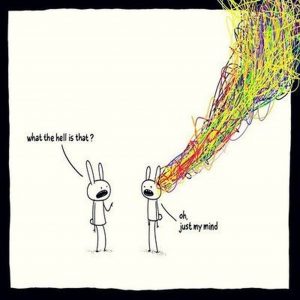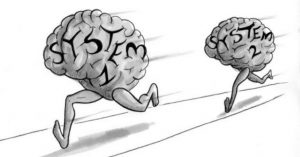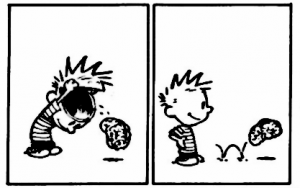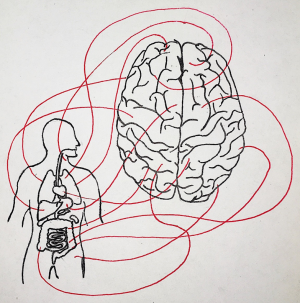
Our minds wander, that is what they do. They are very busy creatures. Even at night when we shut down most of our conscious awareness, our minds still continue playing out dense, symbol-laden versions of our lives, which we then call dreams.
I love my wandering mind. Sometimes. I’m of the belief that the most pleasure one can have is wandering around one’s own mind, or somebody else’s mind, especially as it skips from one thought to the next like a clever, playful, and somewhat precocious child.
We’re very lucky to have minds that do this all the time. Endless, mind-generated entertainment. Say you’re out walking, and see a beautiful spring tulip growing in someone’s garden. Before you know it your mind is using this flower as a springboard for other thoughts. Maybe it presents a thought in the shape of a memory about the last time you saw such a flower, or thoughts about the seasons (“Apart from Corona, such a lovely warm spring we seem to be having”), or the mystery of nature, or maybe another memory, or fantasy about receiving a bunch of flowers from a friend when we’re ill. Lovely, interesting mind stuff.
But the mind can also take another route, especially if our mood is somewhat dampened when we spot that tulip. In fact, with the mind’s inbuilt negativity bias, dark thoughts, even when prompted by a flower, are much more likely than pleasant ones.
How so? Well, maybe the tulip has your mind thinking about how much nicer it might be to have someone there accompanying you on your walk. And so you suddenly you feel a stab of intense loneliness. Or your mind has the thought that your partner hasn’t given you flowers for ages, maybe has never given you flowers, and you feel bitter and upset about it. Or maybe they’re always giving you flowers, but are unwilling to talk about their fears and vulnerabilities with you, and your mind tells you that the flower-giving is a cop-out. If they really loved you, they’d be willing to have the conversations you want to have with them.
Or maybe you feel upset because this flower you’ve spotted in some well-manicured garden indicates that the person who owns the garden has more time or resources than you, and you start to feel envious of them.
Or maybe you wonder why you haven’t got tulips growing at the moment in your own garden, and your mind then helpfully or harshly explains that you love flowers but are somewhat lazy when it comes to gardening, and re-minds you how lazy you are about so many other things, and before you know it, the Inner Critic is unleashed, and giving you a good telling off. Now you are feeling upset and down. And all from a single red tulip you spotted on one of your daily walks!
THE WANDERING MIND IN THERAPY

The latter scenario happens quite often in therapy sessions too. We start talking about one thing that is upsetting to us, and before we know it, the mind start darting around and linking up all the other things that are wrong, unfair, or just painful sources of suffering in our lives.
Sometimes, allowing our minds to wander and share their wandering thoughts with someone else who sits and quietly listens to whatever our minds are saying without judgement or too many interruptions, can be really cathartic and comforting.
Sometimes just the mere act of getting it all out into the open, is therapeutic enough for us, gives us enough distance on our thoughts to see them for what they are (thoughts) and so loosen some of their hold on us.
I call these sessions Mind-Dump Sessions, and I think they can be incredibly important when our heads feel stuffed with all the thoughts heads get stuffed with about a whole range of things that are getting us down.
Mind-Dumps lie at the heart of psychoanalysis and what is now known as psychodynamic therapy. Psychodynamic Therapy is the bottled water of psychotherapy (CBT is its coca-cola) – which is to say, most therapy sessions look and sound pretty psychodynamic in tone and content nowadays, and psychodynamic therapy is still mainly what’s taught on psychology and especially psychotherapy MAs like the one I did.
During a Mind-Dump, which Freud called “free-association”, the client lets their mind wander, and the therapist listens in with half an ear, which Freud called “free-floating attention”.
For Freud, the Mind-Dump approach was as much a logistical, and energy-saving strategy as anything else. If you are seeing 8-10 patients a day as clinical psychologist or psychoanalyst, then it’s probably best, for you, the therapist, to listen to someone speaking in this way. Listening really, really closely to someone’s else’s mind can use up a lot of energy, especially if the mind you’re listening to is super-busy and distracted in its wandering, as most minds are.
Listening to someone with free-floating attention however allows the therapists mind to largely glide over what is being said, until something snags its interest. It’s a bit like the attention you give when listening to a podcast whilst doing the housework. You try to follow what’s being fed into your ears, but your mind is still free to wander too, and sometimes it can wander right away from the podcast for 30 seconds or more if the thoughts that are being aired are not entirely riveting or new.
Freud encouraged this wandering, busy, free-floating attention, both in analysts, as well as for his patients. Their job was to just let their minds wander from topic to topic for 50 minutes, with the analyst occasionally making the odd grunt or comment, but by and large letting herself and the individual she is listening to, skate around inside their own wandering minds.
That in a nutshell is the Mind-Dump model, and having had a couple of years of that (as a client) I recognise its many, many benefits and pleasures as well as some of its problems.
THE PROBLEM WITH MIND-DUMPS
 Here’s the chief problem with Mind-Dumps as far as I can tell. Often the content of what we’re sharing in therapy are thoughts that we have had a hundred, if not a thousand times before. And maybe even shared before with other therapists, or family and friends.
Here’s the chief problem with Mind-Dumps as far as I can tell. Often the content of what we’re sharing in therapy are thoughts that we have had a hundred, if not a thousand times before. And maybe even shared before with other therapists, or family and friends.
The problem is that even if the thoughts feel or sound new to our ears, they are often just a version of a thought, or a sequence of thoughts we’ve had before. A kind of “thought-track” (as in an album) or thought-monologue (as in a speech, delivered by a character in the play of our lives) that we’ve rehearsed thousands of times in our own head, and maybe dozens, if not hundreds of times aloud, or in written form (journals, creative writing) or some other way.
So for example, in the hundreds and hundreds of hours of psychodynamic therapy that I had whilst training, my main Stuck and Struggling thought-tracks and thought-monologues were dumped at my therapist’s feet over and over and over again, largely in the standard way in which they’d always been formulated.
As soon as we approached these topics, my mind did what all minds do, which is find its familiar groove on the things that irked and upset it, and play the cued up track about this topic: my existential loneliness, my abandoning father, my frustrations with my current job at the time (teaching), my relationship issues, the difficulty of emigration, the bullying I’d experienced at school, my struggles to fit in at University, and to The Big Bad World in general, and various other themes and narratives that have given shape to my life.
My therapist would show interest, and often have interesting things to say about all of these things, but I’m not sure we ever really got any further than my well-rehearsed mind tracks and her questions and commentary on them. This was fine to some extent. But in other ways not. For what I wanted from therapy then, and still do, for myself, was to be able to process these narratives of my life in a deeper, wiser, more skilful way. Perhaps it’s my own dissatisfaction with standard talking therapy that led to the training I did after my Integrative Psychotherapy MA, focusing more on Mindfulness Based approaches, Schema Therapy, and ACT.
Another thing I noticed when I was a client in therapy, was that I had no problem in playing My Greatest (Mind) Hits again and again, and often felt vindicated, and consoled in some way when I did so. But this consolation rarely lasted for longer than the session itself. Perhaps because during the session, it really helped to let my mind explain to me and the therapist why I was suffering to the extent I was, to have an explanation for all of this, but this brief moment of lucidity vanished as soon as I stepped out of her rooms. The explanations for my suffering, it seemed after a while, were really only the beginning of the process, not the result of it as I had been previously led to believe.
Insight itself did not, at least in my experience, change the way in which I continued to live my life for good or bad in the here and now, moment by moment.
The experiential shift I was looking for, and which I think a lot of people are looking for, seemed to require something more than just letting my busy, wandering mind do it’s completely natural and lovely busy-wandering thing: darting about from topic to topic, often skating around painful thoughts, and speeding up or changing tack when my mind hit on something painful that it wanted to explore. But also didn’t.
SPEED AND URGENCY: THE UPSET MIND

I don’t know about your mind, but when my mind lands on an upsetting topic, my speech usually speeds up to some extent, and I start to feel a deep tension and urgency in my body, as if I might actually burst if I’m not allowed to finish this chain of thought, which of course just leads to the next chain of thought, and the next.
It’s at moments like this, that my mind most hates being interrupted, and will often fight against interruptions from the person I’m talking to, pretending to listen to them whilst just rehearsing the next thing my mind wants, or at that point feels like it really needs to say.
Often the end of a session (if I’m in therapy) feels like an imposition. “No! Don’t cut me off now!” the mind shouts. “I have so much more to say on this topic! In fact, I have a lifetime of pain and thinking about this to share! DON’T STOP ME NOW! Just another minute or two. Or ten. Or twenty!”
As I started working as a therapist, I would often see clients chasing after their own minds in the same way as I did, and still do (!) struggling to keep up with themselves, but now pulling my mind along in their wake.
And here’s where I also discovered why therapists might choose to employ Freud’s instructions to follow their clients with “free-floating attention”, i.e. to let their minds wander along with their clients or patients, for both of us just to surrender to this distracted, wandering mind-dump.
Hopefully, when a mind-dump is happening, as long as the therapist is working on staying attuned to where the other person’s mind is speaking from, and asking a few searching questions, the mind in question will eventually stumble in time on the thoughts it needs to have to feel better or lead a more fulfilling life.
However, as I too became a little more skilful at recognising my own mind states and those of others, I started to feel at times a bit like an ice-skating coach, standing on the sidelines, watching the person who had entrusted me with this task of helping them take care of their minds, carry out a series of deft and intricate mind-manoeuvres one after the other as if that itself was the point of our session.
I would watch with awe the various mind-flips and loops, the Euler, The Salchow, and those magnificent triple Lutzes and Axles. I would tell myself that just being there watching their minds do their stuff was enough, but I don’t think I ever completely bought into that idea.
When our minds are “flipping out” in some way, the knots they sometimes tie themselves into are usually driven by pain and suffering. Sometimes joy and exhilaration, but more often than not some form of suffering. Joyful mind states are not that common in therapy for understandable reasons. And yet, talking in a session, especially when doing a mind-dump, doesn’t necessarily lead us out of misery into something less miserable. Why is that?
ISN’T THERAPY SUPPOSED TO BE FOR TALKING, TALKING, TALKING ABOUT MY THOUGHTS AND EMOTIONS?

The pain-generated energy which we sometimes call “negative emotions” (fear, anger, sadness) is the electricity of life. This can often be diverted to very useful and helpful problem-solving ideas, creative projects, or channeled into seeking deep, existential paradigms for the ongoing crisis of being human.
Often this will come directly out of a Mind-Dump, those incredible feats of verbal dexterity. But I also noticed as time went by that when I had seen the same flips, and toe-loops, and even those incredible Lutzes and Axles again and again from the same person, I started taking them for granted to some extent. They no longer took my breath away, no longer kept me entranced, as if watching a gripping thriller. Perhaps you have experienced this too yourself when listening to someone else do a Mind-Dump?
It rarely happens when we’re the one mind-dumping though, as our own minds are especially good at getting us deeply fused and hooked into their content.
That said, I’m never completely bored by anything the human mind comes up with. I still think that minds, and human stories, no matter how many times I’ve heard them before, are fundamentally interesting and mysterious. But of course I would think that, having a mind! And especially a mind likes to think and listen to other people thinking.
So even a thought repeated for the 1000th time, like a great song or poem, always presents new tangents for discussion.
And yet, sometimes in a session, I find myself feeling a little bit disengaged from whatever a client is talking to me about, and this I have come to realise is a signal to my mind that their mind had skated off on its own little ice-rink. For both of us, there is still the expectation that having me there on the sidelines, asking the odd question, even if partially engaged with what they’re saying, might somehow produce a different outcome than the last time their mind-stuff spilled out. But I don’t like to feel disengaged and disconnected from someone when they’re talking. Unfortunately though, this can sometimes occur when we’re listening to Mind-Dumps.
I also noticed that some of my clients (though certainly not everybody) started to question whether mind-dump sessions are useful or helpful enough for what they want to get out of therapy, which for many people is some version of:
a) finding ways to deal better with life’s many challenges, and
b) getting that little bit closer to living some version of that rich, full, and meaningful life that we all envisage and struggle for, but also often struggle to put into practice.
How to accomplish this with minds like pinball machines? Minds that wander all over the place as minds often do, bumping into painful thoughts again and again, launching themselves into pirouettes and leaps of distress or fault-finding analysis every time they hit an obstacle?
Are you aware of how much your mind does this? Sometimes, I am, but usually not. Why is that?
ARE MIND-DUMPS A FORM OF AUTO-PILOT THINKING?

The mind is largely on auto-pilot, it has to be so in order to conserve energy. It does less of this when it’s in flow, as in when I’m counselling, or writing, or reciting my poetry koans, or reading something that I’m really interested in. But the mind is so set on wandering from one thing to the next, that it’s often not in this state of flow at all.
In these autopilot moments, our minds are just doing their mindy-thing, using our mouth to give voice to the mind’s thoughts, jabbering away as fast as we can, hoping that at some point we’re going to alight on a word-formulated notion that will make all our word-formulated problems miraculously vanish, or go away. It can feel when we’re doing this that we are in fact going somewhere, even if the mind is largely going around in circles, that’s fine too. A lot of life is about going around in circles, quite pleasurable circles, and why should therapy be any different?
Unless our auto-pilot minds are flying us to destinations that we find upsetting or problematic that is. Then we may decide to pay a bit more attention to the way they’re flying rather than just the content they’re carrying.
Poor minds. I do feel sorry for them, don’t you? Think of how much we expect from our own hard-working, always-busy, largely auto-pilot-driven minds! We’re continually relying on them to (somehow) come up with insightful and interesting analysis, and hopefully a definitive solution, to every dilemma we face in our uncertain world and more than uncertain lives. And all they have to do this with is thoughts constructed out of words.
w o r d s
Made of little squiggly letters, just like the ones you’re reading right now.
It’s a big burden to place on a fist-sized piece of tofu sitting between our ears, a piece of tofu that was largely “designed” just to keep us alive, as opposed to make our lives more pleasant or easier to get through. No wonder we sometimes, literally, drive ourselves insane with our own wandering, and busy tofu-brains.
That said, mind-dump sessions often hit the spot, and if they are doing so for you, let’s continue in that vein, as this is exactly what your mind needs for now. You can also stop reading this piece if that’s the case, job done 🙂
For this is not a diatribe again Mind-Dumps, far from it. Some of my most enjoyable ways of engaging with others is through a mind-dump, even if I might not hold their attention all the way through. This article itself is a kind of mind-dump, although I’m also trying to keep my wandering mind somewhat on track.
The somewhat circuitous track leading to the following distinction.
TO MIND-DUMP OR NOT-TO-MIND-DUMP?
 Perhaps before your next session, see where your mind is at with regard to what it needs from the session itself. If it needs to just wander around and do some pain-driven pirouettes and triple Lutzes in the hope of expending some of the suffering energy of your mind out into the room, into someone else’s ears, someone else’s mind, let’s do that!
Perhaps before your next session, see where your mind is at with regard to what it needs from the session itself. If it needs to just wander around and do some pain-driven pirouettes and triple Lutzes in the hope of expending some of the suffering energy of your mind out into the room, into someone else’s ears, someone else’s mind, let’s do that!
Even if it means that my mind might occasionally go into a sort of “free-floating attention” a la Freud, in the process, that’s OK, and 100% kosher as far as psychotherapy is concerned. If you’re ever worried about whether my mind is doing this though, you can always check by asking where my mind is at, and I’ll happily tell you.
But I would also urge you, especially if you are aware that your mind is stuck in one of its loops of suffering, either before the session, or during it, that you maybe alert me to this so that we can try to do something to help your mind (and sometimes even our minds) step out of their well-worn grooves and explore other ways of thinking or feeling.
I would suggest though that this is something that needs to come from you predominantly rather than me dragging your already-struggling mind to the water from which it has no intention of drinking. Because this is something else I’ve learnt after a decade or two of therapising.
MINDS HATE TO BE INTERRUPTED OR TOLD WHAT TO DO

Ongoing, close awareness of my own mind (especially during different forms of focused mind-awareness practice) has taught me that our minds for the most part don’t like to be interrupted or told by anyone, including ourselves, what to do.
When my mind has launched itself into whatever routine it is engaged in working through, often with the hope that by doing so, it’s going to eventually land on THE ANSWER to all my problems, it is deeply reluctant to give ground in any way. Does your mind work like this too sometimes?
The mind at these moments doesn’t seem to be able to recognise, that if thinking was the answer to all our problems, it would probably have reached an answer to those problems by itself by now.
Or maybe it hopes that my mind (i.e. the therapist’s mind) is going to do that for their mind, even though we both have identical human minds? Which is to say that we both have a fairly intelligent, fairly well-read adult human minds. So why haven’t we been able to think our way yet out of every impasse we find ourselves in 🙂
[Answers in our next session, please].
Instead the mind just keeps on whirring away in the hope that it will get there eventually.
And sometimes it does. Sometimes, uninterrupted thinking through many years of weekly mind-dumping sessions succeeds by whatever metric we measure that success by. It’s also such an interesting process that it makes sense to do it for at least 50 minutes a week – at least to me.
But this is also why knowing how our own minds work and how it feels from the inside when our minds are thinking and worrying about things, is really essential. Sometimes a mind-dump is the answer. Sometimes not.
GETTING YOUR MIND ON-BOARD FOR EXPERIENTIAL WORK

If we are asking our minds to do something different in therapy from what they normally do (wander around, bumping into painful thoughts, which then create more painful thoughts, and more wandering around until the time runs out) we really need to get our minds on board with this. We need to say to our minds, maybe even before our session with the other person (the therapist) something like this:
“Mind, I’d really like to go a bit deeper on this issue today, which may require us utilising some processing techniques which you probably won’t like because they will constrain you, to some extent, constrain your freedom of movement. Just for a while. Maybe for over half the session. Is that OK? But we’re doing this for your own good, yeah? Like the way I sometimes keep my body still so that blood might be drawn from it, or allow another person to give me a massage or some physiotherapy in order to feel better or heal. Hopefully mind, if you allow us to do this together, we might experience something new or different with regard to your well-worn thoughts and inner dialogues/monologues. So might I be able to twist your ‘arm’ dear mind, just for today, to do this with me?”
This is what I’d invite you to do, if you want to invite your own mind to give up on a potentially enjoyable mind-dump for some experiential processing. Experiential processing can also be deeply enjoyable and interesting, but sometimes it isn’t. Sometimes, it’s more like doing some exercise that your body needs, but takes a bit of effort and struggle.
When you negotiate this with your mind in the form of an inner-dialogue, please listen carefully, with kindness and compassion to your own mind’s resistance. Also listen carefully to what your mind says as it reads through the suggestions for focusing/processing practices I’ve shared with you below.
Notice the reasons it gives you for resisting these practices. Try and become as interested in what your mind doesn’t want to do, as what it does. Usually my mind doesn’t want to do stuff because it’s scared or mistrustful of the experience or its outcome. Or because it’s going to take some effort to do. Sometimes mind needs lots and lots of patient inner-dialogue to help them work through this fear so that they can try out new things, which they might even learn to appreciate in time. Patience, patience, patience. Kindness, curiosity, kindness.
When you’re having this inner dialogue with your mind, see if its resistance is mainly about fear of discomfort (“This is new, so unfamiliar, so perhaps best not to try it”) or mistrust (“Why would that work/help?”) or something else.
After having this chat with your mind, YOU (not your mind) might choose, at points in our session, or even for a whole session itself, to override the mind’s natural/default fear of discomfort and change and try out some experiential processing.
We often override our own mind’s fear and mistrust in this way. Otherwise, we’d never give birth to children (the excruciating pain!), or go to a dentist, or risk talking to someone who looks interesting but who might reject us if we approach them. We do some of these things because the outcome or the experience we’re seeking is more valuable to us than staying in the comfort of our own fearful minds. Even if those minds are suffering terribly, there is still some comfort of staying within the well-worn, suffering grooves of what we’ve always done and how we’ve always thought. The great thing about therapy, is that if we treat our minds and each other with respect and kindness, we can’t really go wrong either way. Mind-dump, or Experiential Processing, something useful or helpful will no doubt emerge.
But only you can make this call about what you would like to do with your busy, wandering mind during our sessions, and I will go with whatever decision you make with your mind for your mind.
Because ultimately, it’s your mind, not mine, and you are its boss (at least theoretically) even when it’s treating you more like a skivvy or a whipping boy, driving you relentlessly, or beating you up in the hope that you’ll somehow think or work better or faster, or more pleasurably if you follow that train of thought or another. We’re all riding some kind of Chattanooga Choo Choo of the mind, that’s a given.
WHAT IS EXPERIENTIAL PROCESSING?

Below I’ve listed some of the ways that I like to engage experientially with my own, as well as someone else’s busy, wandering mind. You will notice that all the processing strategies below have three important aspects to them:
a) EXPERIENTIAL PROCESSING SLOWS THE MIND DOWN
When the mind is upset it speeds up. So even though it is often saying some really important things to us in the process, the delivery is often at such a breakneck speed that we are unable to really “hear ourselves” think, and so process things at a deep, heart-level.
So any experiential practice requires us to first of all find a way to put the brakes on our runaway minds. In my experience, minds really, really, really don’t like this! This is also why our minds often fight against doing things like meditation and yoga.
Imagine you’re driving along at 60 mph, covering a lot ground, wind blowing in your hair, the perfect soundtrack playing on the stereo, feeling free and totally unfettered And then SUDDENLY the sign ahead (for no good reason -as far as our minds are concerned) asks you to slow down to 10 mph, or even 5? Minds don’t like doing this, even if it’s something they sometimes need, or other people need from us.
b) EXPERIENTIAL PROCESSING REQUIRES THE MIND TO FOCUS ON JUST ONE THING
As described above, when we are upset, it’s really hard to focus on one thing. Our minds are often all over the place, and we jump from topic to topic haphazardly, in the hope of alighting on some thought that might make us feel better.
Unfortunately, more often than not, one painful thought leads to another painful thought, which then leads to a chain of painful thoughts that wrap themselves around us like a magician being lowered into a giant glass cube filled with water. We’re about to drown, but our minds are still telling us that as long as we keep wriggling, as long as we keep those flustered and flurried thoughts coming, the “key” might shake itself loose from one of our pockets.
“Throw enough shit at a wall, and some of it will stick,” is often the mind’s mantra (it’s not called a mind-DUMP for nothing). And sometimes this does happen. Which is great when it does. But often the mind just starts drowning in its own misery. This is painful for me to witness as a bystander, and even more painful when one is the owner of the mind in question that is asphyxiating itself on its own thoughts in the hope that thoughts alone are going to help us to escape from the multiple ways in which we suffer.
c) EXPERIENTIAL PROCESSING PRACTICES HAVE A VERY SPECIFIC, TARGETED PURPOSE BEHIND THEM
The mind-dump is a kind of free-wheeling mind state, and minds love this of course, because minds love to be free. This is also why we treasure our minds: they are wonderfully, gloriously free! Free to have nice thoughts, horrible thoughts, scary thoughts, and sexy thoughts, miserable thoughts and transcendent thoughts. They are the ultimate free agents, and so are naturally attracted to laissez-faire, free-wheeling sessions, and free-wheeling therapy. Which also helps to explain why a talking cure created by a German-Jewish neurotic over 100 years ago is still going strong.
Freewheeling, mind-dump session are often intensely interesting, even “fun” in a way (they are for me). So even when the thread of what we’re saying, or where we’re “going” with any train of thought, may be unclear, it’s hard not to feel we’re going somewhere. And maybe we are? Who knows.
Experiential Processing doesn’t just cross its fingers and hope for the best. There should always be a carefully conceptualised and mutually understood reason for doing any experiential processing.
If you’re not sure what the purpose of any of the practices below are, please always ask me. Why would your mind agree to doing something if it can’t be convinced (to some extent), that there is a good reason for doing so? None of us like paying our taxes, but there is a well-argued necessity behind taxation, and if we are patient and explain to our minds why we need to painfully give away some of our hard-earned cash, we can sometimes get them to agree. If not, fortunately for all of us, there are also pragmatic and somewhat dispassionate institutions (HMRC) who enforce this necessity whether our minds like it or not.
So even if many of the suggestions below may feel at first unnatural, or uncomfortable, or anxiety-provoking, a well-informed mind can more often than not get behind the most challenging tasks. But I’m not the HMRC, and would never enforce or force experiential processing on anyone. If you feel they would be helpful though, please request we do some of these in your next session. If not, let’s continue with more freewheeling, psychodynamic sessions, which I really love doing too.
SOME EXAMPLES OF EXPERIENTIAL PROCESSING

Briefly, here are a few examples of some Experiential Processing Practices that I like to use with myself and with clients when we’re doing something other than mind-dumps. I haven’t explained these in great detail below, as I think it’s always better to chat about each process before we embark on it, so that we can also take into consideration your mind’s resistance to the process, and make changes in order to accomodate your unique and interesting mind, but here’s the gist of them:
1) Hypnosis/Guided Meditations: I am not a trained hypnotherapist, but I have been trained in providing therapeutic guided meditations, and in doing this training, I discovered that there isn’t a huge difference between the two. Both rely on the therapist guiding the client into a light trance state, where the mind is more open to different perspectives and new experiences.
2) Chair Dialogues: This is where we take different parts of the mind, parts that are often in conflict with each other, and get them to talk to each other, and acknowledge each other’s struggles in order to build greater cohesion and team-work between the different parts of the psyche.
3) Visualisations: This is a great way of exploring difficult past experiences, and trying out diffrent ways of interacting with painful memories as well as painful mind states.
4) Unhooking/uncoupling from a Mind Stuck in a Painful Loop: Because minds do this so often, there are hundreds of strategies for helping our minds to unhook from thoughts that are not helping us.
5) Eye Movement Desensitization and Reprocessing (EMDR): EMDR is another wonderful way of going deep into processing and making peace with a distressing or traumatic past or present event.
6) One on One Processing/Focusing: This is another way of slowing down the mind and giving us space for deep reflection and feeling into areas of our experience where we don’t often go. The therapist will often signal to the client in the midst of their mind-dump (perhaps by holding up a pencil) that s/he has spotted a place of suffering which the mind is wanting to get away from, perhaps by shifting topic just as it alights on the nub of the pain. The client will then put brakes on her mind for a few minutes so that the painful thought can be engaged with in the body in order to process it more fully. Often this is done by using R.A.F, or something similar (see below).
7) R.A.F: This process, based on Tara Brach’s R.A.I.N helps the mind to come to terms with overwhelming thoughts and feelings so that we can focus on doing something meaningful or helpful to our lives instead.
This is not a comprehensive list. There are hundreds of ways of doing experiential processing, and most of the psychology that has been developed post-Freud is focused on these practices, especially in the last 50-60 years.
I look forward to hear what you and your mind have in store for us in our next session.
A good old-fashioned Mind-Dump? Great!
Some experiential processing? Wonderful.
Thanks for reading 🙂
